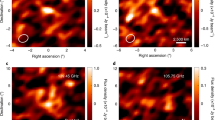Abstract
COMET Donati, 1858VI, was a spectacular comet, famous for its coma with multiple haloes, seen, described, and measured by many observers using optical telescopes. The haloes were roughly parabolic envelopes with vertices towards the Sun forward from the tail axis and the ‘foci’ near the apparent nucleus of the comet. The envelopes appeared to be uniformly spaced radially from the nucleus. Because of the regularity and observed sharpness of these haloes, I assume here that they represent repetitive ejection of material from a single active area exposed successively to solar radiation as the solid cometary nucleus rotated1.
This is a preview of subscription content, access via your institution
Access options
Subscribe to this journal
Receive 51 print issues and online access
$199.00 per year
only $3.90 per issue
Buy this article
- Purchase on Springer Link
- Instant access to full article PDF
Prices may be subject to local taxes which are calculated during checkout
Similar content being viewed by others
References
Whipple, F. L. Nature 276, 15 (1976).
Schmidt, J. F. J. Pub. Athens Obs. Ser. 1, 1 (1863).
Bobrovnikov, N. T. Astr. J. 59, 357 (1954).
Winnecke, A. Mem. Acad. Imp. Sci. St Peteresbourg Ser. 7, 2, 15 (1859).
Schmidt, J. F. J. Astr. Nach. 59, 97 (1863).
Whipple, F. L. Bull. Am. astr. Soc. 9, 563 (1977).
Author information
Authors and Affiliations
Rights and permissions
About this article
Cite this article
WHIPPLE, F. Rotation period of comet Donati. Nature 273, 134–135 (1978). https://doi.org/10.1038/273134a0
Received:
Accepted:
Issue Date:
DOI: https://doi.org/10.1038/273134a0
This article is cited by
-
Comets
The Astronomy and Astrophysics Review (1993)
-
Comets
The Astronomy and Astrophysics Review (1993)
-
Expanding haloes in cometary comae
Nature (1981)
Comments
By submitting a comment you agree to abide by our Terms and Community Guidelines. If you find something abusive or that does not comply with our terms or guidelines please flag it as inappropriate.



